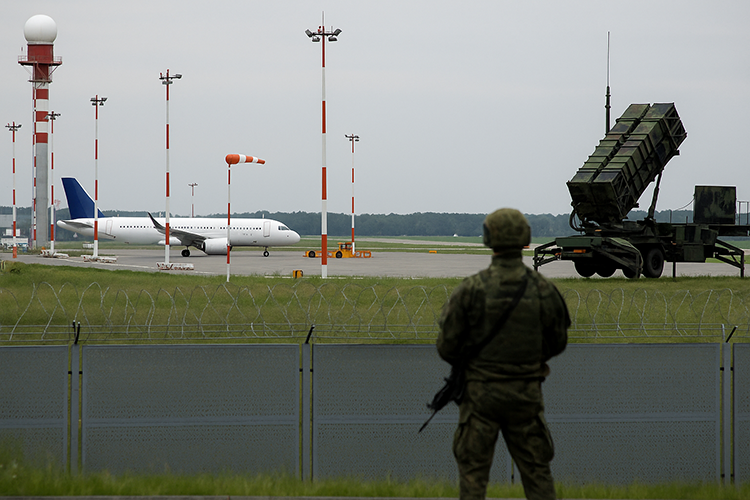Drone Violations of Polish Airspace Test Alliance Defenses and Market Confidence
Airspace restrictions and defense deployments ripple into aviation, logistics, and infrastructure investment.
Poland has entered one of its most serious security episodes since the start of Russia’s war in Ukraine, after at least 19 Russian drones crossed into its airspace during overnight strikes on Ukrainian territory earlier this week. According to Reuters, Polish F-16s supported by Dutch F-35s, NATO surveillance aircraft, and refueling planes intercepted multiple drones, while one UAV struck a house in the village of Wyryki-Wola in Lublin Voivodeship, damaging its roof but causing no injuries. The government imposed sweeping air-traffic restrictions in eastern regions, banning drone flights and small aircraft operations until December 9, while allowing commercial flights above three kilometers to continue. The incident, which Polish Prime Minister Donald Tusk described as the gravest threat to national security since World War II, has prompted NATO consultations under Article 4 and an emergency UN Security Council debate scheduled for September 12.
The crisis coincided with a surprising diplomatic development. The United States announced that Belarus would release 52 political prisoners, including 14 foreign nationals, in exchange for partial sanctions relief on its national airline Belavia. U.S. envoy John Coale confirmed the move, which allows Belavia to service and source parts for its existing fleet, though broader sanctions remain in place. Minsk made the announcement just as it prepared to host joint military drills with Russia near the Polish and Lithuanian borders. For Warsaw, the juxtaposition of drone incursions launched from Belarusian territory and sanctions relief for a Belarusian state company sends a troubling message at a time when deterrence is critical.
Analysts interpret the drone violations as calibrated provocations designed to test NATO’s defenses, expose response times, and highlight the cost imbalance between low-cost UAVs and expensive allied interceptors. The Council on Foreign Relations has warned that such tactics are aimed at probing thresholds without triggering outright war. The Moscow Times described the operation as the boldest test yet of Western airspace readiness. NATO allies have reacted swiftly, with Germany expanding its air policing missions and the Netherlands deploying additional Patriot missile batteries, underscoring that the alliance is treating the incursions as a systemic threat rather than an isolated episode.
The investment implications are immediate. Airlines are diverting routes away from eastern Poland, insurers are reassessing premiums for aviation and cargo, and logistics operators in Lublin, Białystok, and Rzeszów report mounting pressure from tenants to incorporate resilience features such as backup power, secure communications, and alternative transport options. Some occupiers are shifting capacity toward hubs west of Warsaw, particularly Łódź and Poznań, which are seen as more stable in the current environment. In Warsaw itself, the capital’s position as NATO’s coordination center is bolstering demand from diplomatic, defense, and consultancy occupiers, partially offsetting the volatility further east.
For investors, Poland now represents a dual reality. On one side, the eastern border remains exposed to repeated probing, with elevated risk for assets closest to Belarus and Ukraine. On the other, NATO’s rapid deployments, Poland’s modernization program, and continued EU backing reinforce the country’s long-term appeal as one of the most resilient destinations in Central and Eastern Europe. The U.S. sanctions relief for Belavia adds a further complication: while the release of political prisoners demonstrates diplomatic progress, it raises concerns in Warsaw and Vilnius that Belarus is being rewarded despite facilitating drone incursions. Should Minsk continue to tolerate UAV launches, calls inside the EU for tougher sanctions on Belarusian aviation, energy, and potash sectors are likely to intensify.
The trajectory from here will depend on whether Belarus reins in drone activity and whether NATO deterrence proves sufficient to prevent escalation. A best-case scenario would see limited incidents, successful defensive interceptions, and gradual relaxation of restrictions by December. The more probable baseline is a prolonged period of tension, with continued drone harassment, NATO reinforcing its eastern flank, and aviation and logistics operators adapting to a climate of persistent uncertainty. The worst-case scenario, in which a drone strike causes civilian casualties or damages critical infrastructure, could force NATO into harsher military responses and raise investor risk premia across the region.
For the real estate and investment community, the lesson is clear. Geopolitics has moved from being a background risk to a frontline factor shaping market sentiment. Poland’s strong fundamentals, EU integration, and NATO security guarantees continue to underpin its attractiveness. Yet investors must now incorporate security overlays into their risk assessments, from infrastructure resilience to regional exposure.
Robert Fletcher, CEO & Editor-in-Chief of CIJ EUROPE, commented: “This crisis demonstrates that the investment story in Poland and CEE cannot be separated from the security environment. NATO’s response shows the strength of the collective backstop, but for investors it means factoring in resilience and risk management alongside yield and location. Poland remains one of the most compelling markets in Europe, yet it is also where geopolitics and real estate now intersect most directly.”
Editor’s note: The views expressed in this evaluation reflect professional analysis of potential implications for the real estate and investment markets, and are not definitive forecasts of government or military actions.”
Sources: comp.









